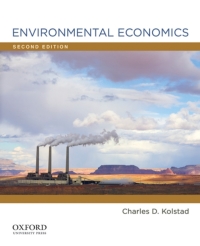Carbon dioxide is well known as the most significant greenhouse gas, leading to climate change and global
Question:
Carbon dioxide is well known as the most significant greenhouse gas, leading to climate change and global warming. But other gases are also greenhouse gases contributing to global warming and thus appropriate to regulate in controlling the problem. One of these is methane (uncombusted natural gas). Methane and \(\mathrm{CO}_{2}\) differ in how a kilogram in the atmosphere affects warming, and they also differ in how quickly the gases leave the atmosphere.
Although we are oversimplifying the physical science, assume that after a kilogram of methane or \(\mathrm{CO}_{2}\) are emitted into the atmosphere, they decay exponentially, with half of the \(\mathrm{CO}_{2}\) disappearing in 100 years and half of the methane disappearing in 10 years. Although methane disappears quickly, while it is in the atmosphere it is more problematic for global warming in the sense that a kilogram of methane in the atmosphere causes approximately 25 times the warming as a kilogram of \(\mathrm{CO}_{2}\).
For the questions below, assume a discount rate of \(5 \%\) per year.
a. For each gas, graph the stock of gas remaining in the atmosphere following the injection of 1 ton into the atmosphere. You can put the two lines on the same graph. Take your graph out at least 100 years. What is the persistence rate for each gas?
b. You are advising the EPA on what emission tax to place on methane and \(\mathrm{CO}_{2}\). Assume first of all that the marginal damage from a ton of \(\mathrm{CO}_{2}\) in the atmosphere is \(\$ 1\) per year per ton and it is constant over time, and independent of the stock of greenhouse gases in the atmosphere. What would be the ratio of the tax on methane to the tax on \(\mathrm{CO}_{2}\), using efficiency as your guide in setting taxes?
c. How would your answer to (b) change if you only considered a horizon of 10 years? Of 50 years? Of 100 years? [One hundred years is the figure the Kyoto Protocol uses to consider trade-offs between methane and \(\mathrm{CO}_{2}\).]
d. How would your answer to (b) change if marginal damage from a ton of \(\mathrm{CO}_{2}\) increased at the rate of \(1 \%\) per year?
e. Compare your answers to (c) and (d).
Step by Step Answer:






